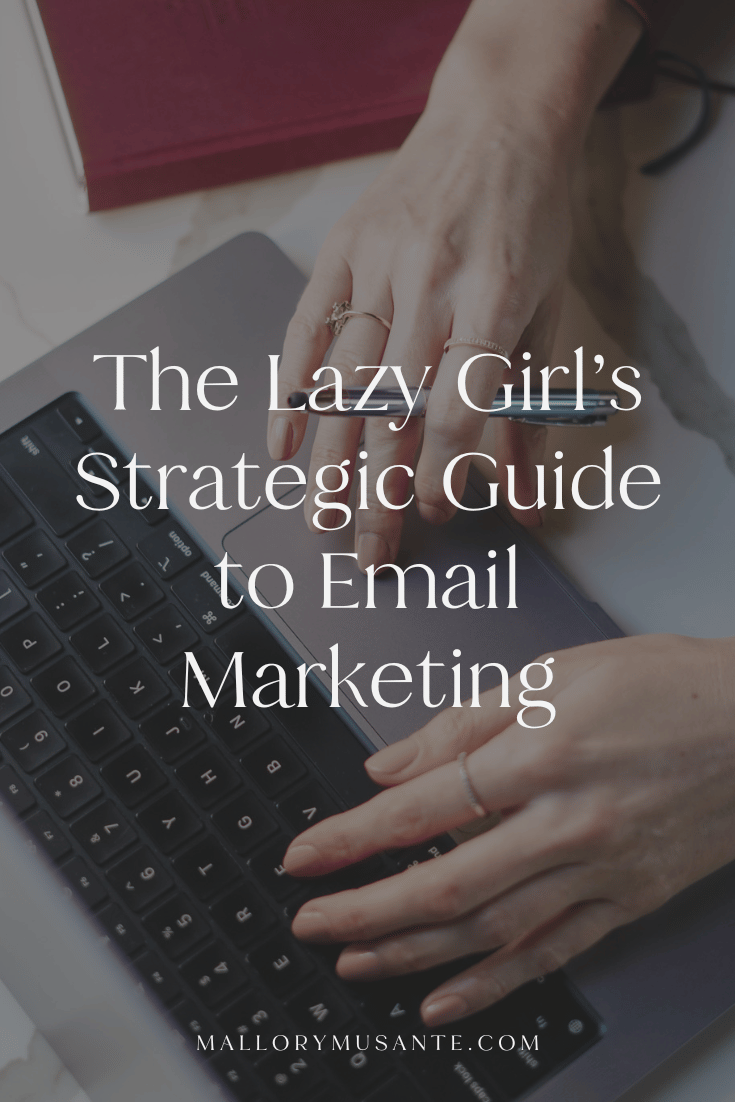2025 Business Planning and Goal Setting with a Fractional CMO
There are countless ways to do your yearly planning and goal setting for your business. I’ve actually done it a lot of different ways myself but one thing is always true — Data helps make this process a heck of a lot easier (and strategic!)
Data provides you a roadmap and puts a big ol’ spotlight on areas in your business you should be paying attention to so you can then plan and shift your efforts to address what the data is showing you.
Because of this, it is the very first step of my yearly planning process for myself and my clients which includes:
Evaluate your 2024 performance
Formulate the plan using 2024 data
Finalize and set KPIs/goals
So let’s walk through this process together.
Here’s a look inside my 2025 business planning and goal setting process:
Before we dive in, I want to clarify what I mean when I say data. Yes, I mean all your analytics and numbers, but you are also consistently collecting data through observations whether that’s interacting on social media, the conversations you’re having with prospects, or anywhere else.
We love hard numbers because it’s more tangible. We can put a finger on it and know it’s real. But that observational data is also just as important. This is often where you’ll start to notice if there are shifts in your industry, in buyer behavior, or anywhere else. Sometimes you have hard numbers to back up these observations and sometimes you don’t… But that doesn’t mean those observations are any less valueable.
Ok now that we have that covered, let me step off my soapbox and get into the nitty gritty.
Step 1: 2024 Reflection & Evaluation
We can’t fully plan where we’re going without first knowing where we’ve been (aka what’s been working and what hasn’t).
I always sit down in early Q4 to start this process for myself so I have plenty of time to review and revisit before the beginning of the year. Here’s the key data I’m looking at for myself and my clients:
Leads by marketing channel
Revenue by marketing channel
Percentage of revenue by offer
These are the 3 metrics I always start with because they often start to tell a story. (If I have data from previous years, I'll also compare these 3 metrics to those years too to help identify any patterns or trends.)
Here's why I start by looking at these 3: One of my clients knew the majority of her leads were coming from Instagram but when we looked at revenue by channel, we learned that Instagram was not bringing in the most revenue, her SEO efforts were. That one realization flipped how we were going to build her marketing strategy for the year ahead (aka which offers she would promote and where).
If we need additional information (which we often do), then we dig into all the marketing platform specific metrics to see what’s going on there. This could include:
Overall web traffic (broken down by traffic source)
Average time on site
Bounce rate
Impressions by social channel
Clicks to website by social channels
Email open and click rates
And so many others…
The metrics you look at are going to be specific to your marketing mix and how you’ve designed your specific marketing funnel. The goal here is to make sure that your audience is moving through your funnel the way you’ve intended them to. If you find any sticking points, that’s where you need to make adjustments.
And then the last thing we're looking at in this step is expenses to see if there’s anything unnecessary you’re spending money on and can cut or if there are areas you want to invest in so you can budget it for it.
(I once helped clients save $2544/year by changing the software they were using and that money got to be reinvested into the company to drive further results so this step could be big savings for you. Don't skip it!)
Tools to help with this step:
Dashboard: Having all your data in a centralized location or dashboard is ideal so you’re not flipping back and forth between platforms trying to remember what those numbers are and compare them, etc. A dashboard gives you that data all together so you can compare it all right there.
SWOT Analysis: A SWOT Analysis is a great tool to help capture that observational data we talked about earlier. It helps me identify what I’m doing well, where I need support, opportunities I have, and potential threats. This process forces me to take a closer look through a slightly different lens and capture not only the hard data but also the observational data I’ve noticed and collected throughout the year.
Step 2: Formulate the 2025 Plan
Now we use all the data from the first step and start to draw conclusions to formulate our 2025 plan.
But first, I think about any future plans and goals I have so I can make sure to shape the plan to allow me to reach those goals and integrate those plans.
For example, I’m slightly shifting some of my offers in 2025 so I need to make sure that’s aligned and integrated into my marketing plan and I have all the necessary systems set up to support these changes.
I also have a client I recently went through this 3-step planning process with and her primary goal for 2025 was to bring all the pieces of their marketing mix together to create an intertwined marketing ecosystem that supports all their conference and event efforts (since those drive the most growth for them). With this in mind, we were able to craft a highly strategic ads campaign that wraps around the conferences and events they’ll attend in 2025, thus creating that ecosystem that works smarter and harder for her 1-person marketing team.
During this process, you’re going to want to identify if there are areas you feel need to be further optimized or discontinued. You’re really using the data from step 1 to help you determine where to put your resources. Once you have that set, here’s what else I’d recommend during this step:
Identify any “events” you have going on throughout the year: This could include actual events or conferences or it could be dates or things that happen during the year that affect your specific target market (Holidays, back-to-school, daylight savings, New Years resolutions, etc.) or be any launches you want to have throughout the year.
Create a timeline/campaign around those “events”: Put the “events” you identified on a calendar or in a list somewhere so you can then determine if you need to (1) shift your marketing/messaging prior to that event and/or (2) run additional marketing efforts during that time and what those efforts would be.
Use previous data to help predict the results of these campaigns: If you have data available to you, you can then also use it to help you calculate the results of these campaigns so you can determine if they will get your closer to your goals in 2025.
Honestly, this part of the process starts off a bit messy and feels like a giant, complicated puzzle. But once you start to put the pieces into place, the picture comes into view and you’re able to gain a lot of clarity and build the actual roadmap to get you to where you want to go.
Tools to help with this step:
Visualizations: As a visual person and someone that loves simplicity, I try to make my plan as visual as possible. That means I might map out my actual funnel in a visual manner, use flowcharts to show the marketing ecosystem at work, Gantt charts for implementation timelines, and any other visualization I can think of. That way when I (or a client) needs to refer back to the plan for the year, it’s really easy to drop back into it without having to reread a 20 page document.
Step 3: Finalize + Set KPIs
To make your 2025 plan a true roadmap for success, it’s essential to finalize and set some Key Performance Indicators (KPIs). KPIs aren’t just numbers on a page—they’re the signposts that show us whether we’re heading in the right direction, or if we need to pivot.
Before jumping into KPIs, go back through your SWOT analysis and 2025 goals, and assess if you’ll need any additional support—whether that’s new team members, tech tools, or other resources. If your strategy requires specific investments to hit your targets, outline those now. Establish when these resources need to be in place so they’re ready as you approach key milestones in your 2025 plan.
The KPIs you choose will be unique to your strategy and goals, but here are some steps to define KPIs that will keep you focused and on track:
Identify Your Core Goals: Start by identifying your main goals for the year. Are you focusing on revenue growth, increasing customer retention, or brand visibility? Your KPIs should align closely with these primary goals.
Define Milestones for Progress Tracking: What would indicate that you’re progressing toward these goals? Think of these as smaller checkpoints along the way. If your goal is to grow revenue, a milestone might be a monthly or quarterly revenue target.
Link Tactics to Metrics: Dig a layer deeper and pinpoint the specific tactics that will support each goal. For example, if a goal is to increase email list growth, a tactic might be optimizing your lead magnet. The corresponding KPI might be an increase in lead magnet conversion rate by X% each quarter.
To make sure your KPIs are grounded in reality, start with a look back at 2024 data. This benchmark will help you set targets that are ambitious yet achievable and prevent you from setting arbitrary numbers that lack context. Use this data to identify trends, areas of growth, and potential bottlenecks.
Once you’ve established your KPIs, set up a tracking system to monitor them regularly. Record the final numbers for each KPI at the close of 2024, and schedule monthly or quarterly check-ins to evaluate progress. Consistently tracking these KPIs will make it much easier to spot patterns, catch issues early, and make data-backed adjustments to keep your 2025 plan on course.
With these steps in place, your KPIs become more than just targets—they become the backbone of a strategy that keeps you focused, agile, and poised to make the most of every opportunity in 2025.
While I love to set goals and I think we should always be working towards something specific, I also know that our energy has a big impact on achieving our goals. That’s why I think it can be a good idea to have different types of goals. Last year, I set Be, Do, Have Goals to better maintain my energy (and honestly detach from the outcome more!) and it was a complete game changer for me so I wanted to include a link to last year’s yearly planning and goal setting blog here in case you’re interested in learning more.
Looking for marketing support?
Explore how we can work together here.































